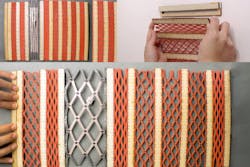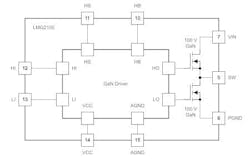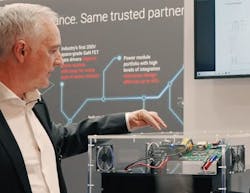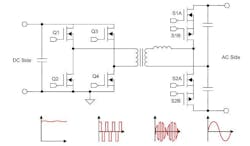Shape-Shifting Metamaterial Antenna Adjusts Operating Parameters
What you'll learn:
- The need for, and benefits of, reconfigurable antennas.
- How metamaterials combined with novel assembly techniques were combined to create a physically reconfigurable antenna.
- The performance flexibility and options offered by such an antenna.
Mechanically steered or adjustable antennas for radar, radio astronomy, and other RF applications have been around since the earliest days of wireless. The mechanical approach was upgraded to electronically steered antennas using phased arrays and, increasingly, MIMO arrangements. But mechanically adjustable (rather than steerable) antennas are much less common and usually limited to a preset set of positions and arrangements (see “Heat-Activated Shape-Shifting Antenna Built with Unique Material and 3D Printing”).
That’s why a mechanically reconfigurable antenna from a multidisciplinary team at MIT is an interesting project, even if it’s only a lab-research project. A user can stretch, bend, or compress their antenna to make reversible changes to its radiation properties, enabling a device to operate at different bandwidths or band segments. With its adjustable frequency range, the reconfigurable antenna could also adapt to changing conditions and reduce the need for multiple antennas (Fig. 1).
To design this versatile reconfigurable antenna, the researchers used metamaterials. These engineered materials can be “programmed” to adopt different shapes, as they’re composed of a periodic arrangement of unit cells that can be rotated, compressed, stretched, or bent.
Changes in resonant frequency or other antenna attributes can be realized by changing the antenna’s effective length or introducing slits and holes into it. Metamaterials allowed the team to implement those different states from only one structure.
Kirigami Auxetic Metamaterials
The team selected kirigami auxetic metamaterials and defined five distinct design criteria. These metamaterials comprise patternable cells with periodic cut designs that enable them to achieve different deformations through compression, bending, and rotation when deployed (Fig. 2).
The connection point between cells creates a four-bar linkage that makes the structure mechanically stable. As a result, cells can rotate clockwise and counter-clockwise and take on specific configurations that create different deformations.
What are Auxetic Metamaterials?
An auxetic material or structure has a negative Poisson's ratio, meaning it gets thicker when stretched and thinner when compressed, which is the opposite of most common materials. This unusual behavior, which stems from a specific internal micro- or macro-structure, results in properties like increased impact resistance, higher density under stress, and improved damping, making them useful in applications from running shoes to biomedical devices to protective armor.
Their arrangement, called a “meta-antenna,” is composed of a dielectric layer of material sandwiched between two conductive layers. To fabricate it, the researchers cut the dielectric laser out of a rubber sheet with a laser cutter. Using physical masking, they also added a patch on top of the dielectric layer with conductive spray paint, creating a resonating “patch antenna.”
They provided details and insight into practical issues of production, as well as reality intruding on an academic project. They found that even the most flexible conductive material couldn’t withstand the amount of deformation the antenna would experience.
To overcome this severe weakness, the team did a many “trial and error” experiments. They eventually determined that coating the structure with flexible acrylic paint protected the hinges so that they didn’t break prematurely.
Simulating the Meta-Antenna
Non-configurable static antennas are modeled and simulated using various software-based tools. For this layered metamaterial antenna, it’s not enough to model it in a given configuration, as the fabrication specifics must also be determined. To do this, the team built a meta-antenna design suite editor for Ansys HFSS (High Frequency Simulation Software) through the Ansys App Builder and ACT Toolkit (Fig. 3).
With this tool, the user can define the size of the antenna patch, choose a thickness for the dielectric layer, and set the length to width ratio of the metamaterial unit cells. Then the system automatically simulates the antenna’s resonance frequency range.
While some of the application for this meta-antenna are somewhat obvious, others are not. For example, they designed and built one antenna model into the headband to create a smart headphone (Fig. 4).
This headphone seamlessly transitions between noise-canceling and transparent modes, while also providing a clear physical indication of which mode it’s in as it expands and bends by approximately 67%. This shifts the resonance frequency by 0.12 GHz (2.6%), which switches the headphone mode. The team’s tests also showed that meta-antenna structures are durable enough to withstand more than 10,000 compressions.
There’s no conventional academic-journal paper, usually limited to four or perhaps five figures and a condensed report, published for this project. Fortunately, if you’re interested in learning more about it, they have posted a lengthy, detailed, and highly readable project report (with 20 figures!) at an MIT research site with the plain title, “Meta-antenna: Mechanically Frequency Reconfigurable Metamaterial Antennas.”
Their report covers all aspects of the project from concept to analysis, design considerations, fabrication issues and steps, test results, and much more. There’s also a very interesting and well-done five-minute YouTube video worth watching.
About the Author

Bill Schweber
Contributing Editor
Bill Schweber is an electronics engineer who has written three textbooks on electronic communications systems, as well as hundreds of technical articles, opinion columns, and product features. In past roles, he worked as a technical website manager for multiple topic-specific sites for EE Times, as well as both the Executive Editor and Analog Editor at EDN.
At Analog Devices Inc., Bill was in marketing communications (public relations). As a result, he has been on both sides of the technical PR function, presenting company products, stories, and messages to the media and also as the recipient of these.
Prior to the MarCom role at Analog, Bill was associate editor of their respected technical journal and worked in their product marketing and applications engineering groups. Before those roles, he was at Instron Corp., doing hands-on analog- and power-circuit design and systems integration for materials-testing machine controls.
Bill has an MSEE (Univ. of Mass) and BSEE (Columbia Univ.), is a Registered Professional Engineer, and holds an Advanced Class amateur radio license. He has also planned, written, and presented online courses on a variety of engineering topics, including MOSFET basics, ADC selection, and driving LEDs.




